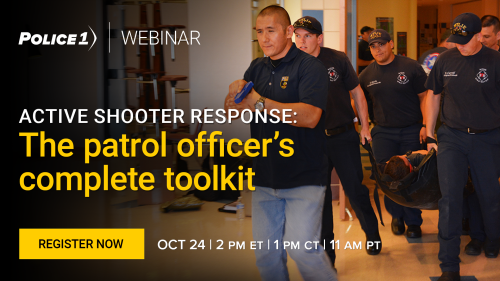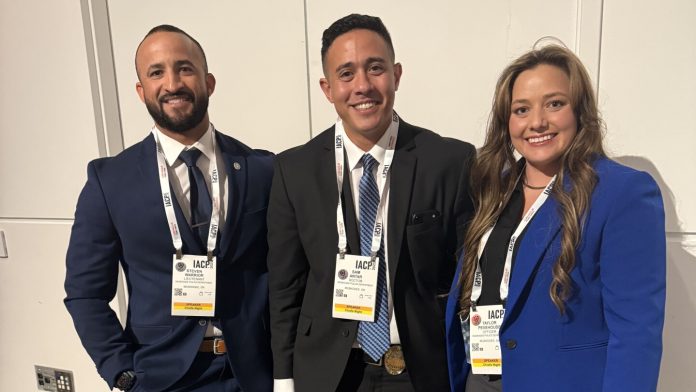DENVER — At the International Association of Chiefs of Police (IACP) conference, Officer Sam Antar, MD, and Officer Taylor Pevehouse, NREMT, from the Muskogee (Oklahoma) Police Department, shared how they transformed a simple idea into a fully functioning Medical Support Unit (MSU) — a patrol-based medical model that places trained clinicians directly in uniform.
Thank you for reading this post, don't forget to follow and signup for notifications!
Dr. Antar, an emergency room physician turned full-time police officer, and Officer Pevehouse, a Nationally Registered EMT, have blurred the traditional lines between law enforcement and prehospital care. Their program recognizes that in many emergencies, it’s not medics or firefighters who arrive first — it’s the police. Those first minutes, they emphasized, often mean the difference between life and death.
| RELATED: What tools departments and communities need to treat bleeding patients
Recognizing a critical gap in response
The concept was born from a realization that Muskogee’s officers regularly encountered severe trauma before EMS arrived. When Dr. Antar joined the department, he saw that the agency’s medical training was minimal — “a PowerPoint and a tourniquet,” as he put it. To confirm, he attended the police academy without disclosing he was a doctor, discovering that officers received only superficial instruction in life-saving techniques. Convinced that his new colleagues needed something better, he teamed up with Officer Pevehouse to design a program that would provide meaningful medical capability for patrol.
Designing a patrol-based medical model
Using local data, the two demonstrated that Muskogee’s officers were responding to violent incidents at some of the highest rates in Oklahoma, often reaching victims long before EMS. They pitched a plan to city leaders to create a Medical Support Unit that would train and equip patrol officers to deliver early, evidence-based medical care. The result was a simple but powerful idea: every shift would include at least one officer capable of advanced emergency intervention, creating continuous medical coverage across the city.
Overcoming startup challenges
Startup wasn’t easy. Without a dedicated budget, the founders initially paid out of pocket for supplies and training. Later, a local hospital foundation stepped in, awarding a grant that allowed the unit to fully equip its officers with tourniquets, chest seals, airway devices and other lifesaving gear. Muskogee’s leadership then formalized the program, publishing policies, assigning oversight and funding its continued growth.
“We don’t just wait four minutes for EMS — we act in those four minutes.”
Building trust and interoperability with EMS
Today, the MSU includes both full-time and reserve officers who also serve as EMTs, paramedics, nurses or physicians. They continue to work standard patrol shifts but respond to high-acuity events such as shootings, stabbings, cardiac arrests and vehicle crashes. Their patrol cars are marked with medical insignia, and each officer wears a red “MED” rocker beneath the badge — a quick visual cue for EMS and fellow officers during chaotic scenes.
Crucial to the program’s credibility is its close partnership with local EMS. The MSU adopted the same protocols, equipment and documentation used by the city’s ambulance service, ensuring that care transitions smoothly when medics arrive. All police medical encounters are reviewed through EMS quality assurance, and officers participate in joint training, ambulance ride-alongs and trauma refreshers. The result is genuine interoperability: police and EMS operating from a shared playbook.
Early results and lasting impact
Early results are promising. Officers have already provided lifesaving care at multiple scenes where seconds mattered. Supervisors report higher confidence in field operations knowing medical expertise is always present, while community members appreciate seeing officers equipped and ready to help in new ways. The unit’s members also now teach medical courses at the police academy, offer in-service refreshers and conduct CPR sessions in local schools and churches — spreading lifesaving skills beyond law enforcement.
Dr. Antar and Officer Pevehouse have shown that law enforcement medicine no longer has to be limited to tactical teams or special operations. Their message at IACP was clear: “We don’t just wait four minutes for EMS — we act in those four minutes.” By embedding real clinical skill within patrol, Muskogee PD has built a bridge between the patrol car and the trauma bay — one that’s already saving lives and redefining what it means to protect and serve.
Tactical takeaway
Equip patrol officers with hands-on trauma care training and standardized medical kits to ensure the first person on scene can make a difference before EMS arrives.
How could your agency better integrate medical training or partnerships to improve first-response outcomes? Share below.




